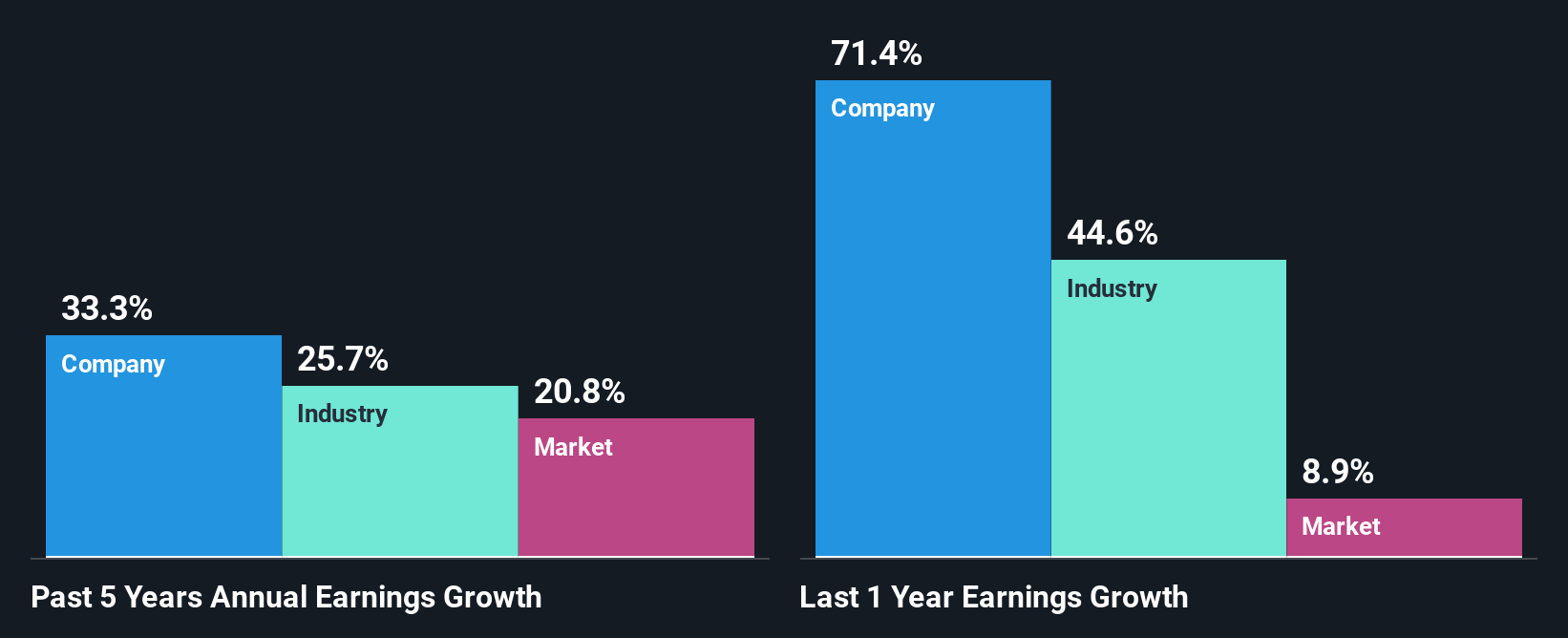- South Africa
- /
- Insurance
- /
- JSE:SLM
Is Sanlam Limited's (JSE:SLM) Latest Stock Performance Being Led By Its Strong Fundamentals?

Most readers would already know that Sanlam's (JSE:SLM) stock increased by 4.5% over the past month. Given its impressive performance, we decided to study the company's key financial indicators as a company's long-term fundamentals usually dictate market outcomes. Particularly, we will be paying attention to Sanlam's ROE today.
Return on equity or ROE is an important factor to be considered by a shareholder because it tells them how effectively their capital is being reinvested. In simpler terms, it measures the profitability of a company in relation to shareholder's equity.
How To Calculate Return On Equity?
Return on equity can be calculated by using the formula:
Return on Equity = Net Profit (from continuing operations) ÷ Shareholders' Equity
So, based on the above formula, the ROE for Sanlam is:
20% = R22b ÷ R110b (Based on the trailing twelve months to December 2024).
The 'return' is the income the business earned over the last year. Another way to think of that is that for every ZAR1 worth of equity, the company was able to earn ZAR0.20 in profit.
See our latest analysis for Sanlam
Why Is ROE Important For Earnings Growth?
We have already established that ROE serves as an efficient profit-generating gauge for a company's future earnings. Based on how much of its profits the company chooses to reinvest or "retain", we are then able to evaluate a company's future ability to generate profits. Generally speaking, other things being equal, firms with a high return on equity and profit retention, have a higher growth rate than firms that don’t share these attributes.
Sanlam's Earnings Growth And 20% ROE
To begin with, Sanlam seems to have a respectable ROE. Especially when compared to the industry average of 16% the company's ROE looks pretty impressive. This probably laid the ground for Sanlam's significant 33% net income growth seen over the past five years. We reckon that there could also be other factors at play here. Such as - high earnings retention or an efficient management in place.
As a next step, we compared Sanlam's net income growth with the industry, and pleasingly, we found that the growth seen by the company is higher than the average industry growth of 26%.

Earnings growth is an important metric to consider when valuing a stock. The investor should try to establish if the expected growth or decline in earnings, whichever the case may be, is priced in. Doing so will help them establish if the stock's future looks promising or ominous. One good indicator of expected earnings growth is the P/E ratio which determines the price the market is willing to pay for a stock based on its earnings prospects. So, you may want to check if Sanlam is trading on a high P/E or a low P/E, relative to its industry.
Is Sanlam Using Its Retained Earnings Effectively?
Sanlam's significant three-year median payout ratio of 66% (where it is retaining only 34% of its income) suggests that the company has been able to achieve a high growth in earnings despite returning most of its income to shareholders.
Besides, Sanlam has been paying dividends for at least ten years or more. This shows that the company is committed to sharing profits with its shareholders. Based on the latest analysts' estimates, we found that the company's future payout ratio over the next three years is expected to hold steady at 55%. Accordingly, forecasts suggest that Sanlam's future ROE will be 17% which is again, similar to the current ROE.
Conclusion
Overall, we are quite pleased with Sanlam's performance. We are particularly impressed by the considerable earnings growth posted by the company, which was likely backed by its high ROE. While the company is paying out most of its earnings as dividends, it has been able to grow its earnings in spite of it, so that's probably a good sign. Having said that, the company's earnings growth is expected to slow down, as forecasted in the current analyst estimates. Are these analysts expectations based on the broad expectations for the industry, or on the company's fundamentals? Click here to be taken to our analyst's forecasts page for the company.
New: Manage All Your Stock Portfolios in One Place
We've created the ultimate portfolio companion for stock investors, and it's free.
• Connect an unlimited number of Portfolios and see your total in one currency
• Be alerted to new Warning Signs or Risks via email or mobile
• Track the Fair Value of your stocks
Have feedback on this article? Concerned about the content? Get in touch with us directly. Alternatively, email editorial-team (at) simplywallst.com.
This article by Simply Wall St is general in nature. We provide commentary based on historical data and analyst forecasts only using an unbiased methodology and our articles are not intended to be financial advice. It does not constitute a recommendation to buy or sell any stock, and does not take account of your objectives, or your financial situation. We aim to bring you long-term focused analysis driven by fundamental data. Note that our analysis may not factor in the latest price-sensitive company announcements or qualitative material. Simply Wall St has no position in any stocks mentioned.
About JSE:SLM
Sanlam
Provides various financial solutions to individual, business, and institutional clients in South Africa, rest of Africa, Asia, and internationally.
Solid track record established dividend payer.
Similar Companies
Market Insights
Community Narratives


